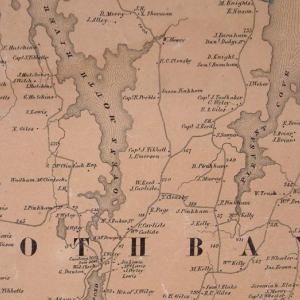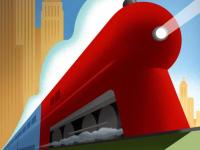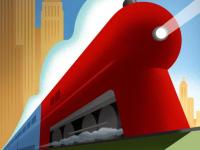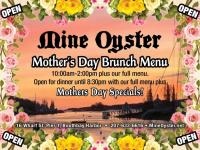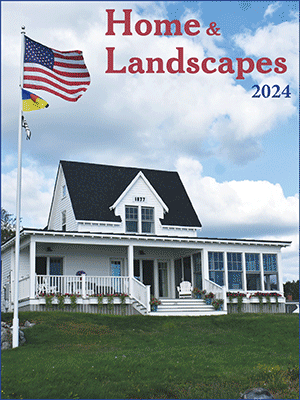Kelley Brook
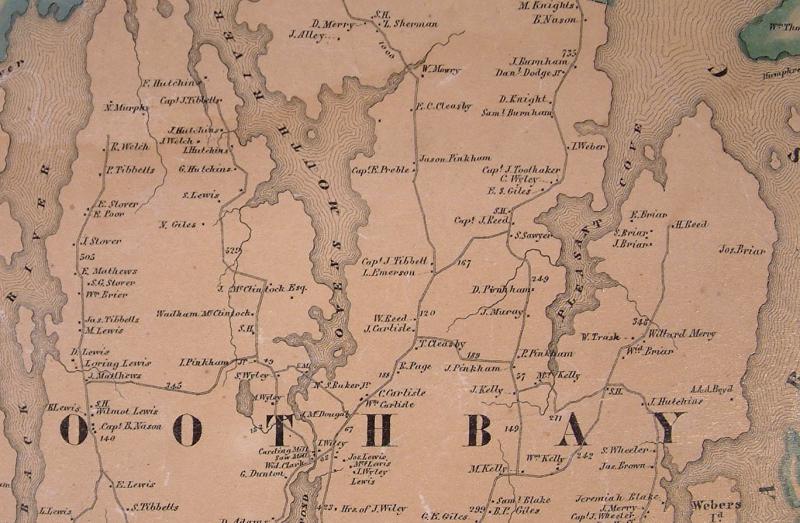 This portion of the 1857 county map shows Kelley Brook at the bottom of Pleasant Cove. Road names didn't exist in town until the 1880s and the spelling of names was still unimportant. Proceeding west from Pleasant Cove to Back River, the town road between "S.H." (schoolhouse) and "J. Kelly" still passed over the old Kelley dam decades after the mill was discontinued. Hardwick Road is between "J. Pinkham" and "T. Cleasby." The road between "J. McDougal" and "S. Wyley" crossed the millsite below Ovens Mouth River, but above the Adams mills below. The road between "I. Pinkham" and "A. Matthews" terminated at present Back River Road.
This portion of the 1857 county map shows Kelley Brook at the bottom of Pleasant Cove. Road names didn't exist in town until the 1880s and the spelling of names was still unimportant. Proceeding west from Pleasant Cove to Back River, the town road between "S.H." (schoolhouse) and "J. Kelly" still passed over the old Kelley dam decades after the mill was discontinued. Hardwick Road is between "J. Pinkham" and "T. Cleasby." The road between "J. McDougal" and "S. Wyley" crossed the millsite below Ovens Mouth River, but above the Adams mills below. The road between "I. Pinkham" and "A. Matthews" terminated at present Back River Road.
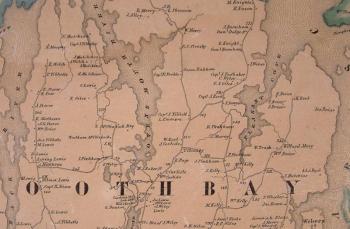 This portion of the 1857 county map shows Kelley Brook at the bottom of Pleasant Cove. Road names didn't exist in town until the 1880s and the spelling of names was still unimportant. Proceeding west from Pleasant Cove to Back River, the town road between "S.H." (schoolhouse) and "J. Kelly" still passed over the old Kelley dam decades after the mill was discontinued. Hardwick Road is between "J. Pinkham" and "T. Cleasby." The road between "J. McDougal" and "S. Wyley" crossed the millsite below Ovens Mouth River, but above the Adams mills below. The road between "I. Pinkham" and "A. Matthews" terminated at present Back River Road.
This portion of the 1857 county map shows Kelley Brook at the bottom of Pleasant Cove. Road names didn't exist in town until the 1880s and the spelling of names was still unimportant. Proceeding west from Pleasant Cove to Back River, the town road between "S.H." (schoolhouse) and "J. Kelly" still passed over the old Kelley dam decades after the mill was discontinued. Hardwick Road is between "J. Pinkham" and "T. Cleasby." The road between "J. McDougal" and "S. Wyley" crossed the millsite below Ovens Mouth River, but above the Adams mills below. The road between "I. Pinkham" and "A. Matthews" terminated at present Back River Road.
There are any number of places in the region that once were bustling hubs of activity, now overgrown and forgotten by most. I was fortunate to have been taken to many of them in the late 1980s by knowledgeable natives born in the aughts and the teens. Having grown up here and having listened to their parents and grandparents, their collective memories went way back. They routinely talked about events as far back as the 1850s with the intimacy of having heard about them at only one or two removes.
That long reach
The first time I grasped that long reach back in 1986, I said, "But you're talking about the 1850s. How do you know that?" Hazel McCobb Poore (b. 1909) looked up at me from her knitting and said, "I listened." Another who had that long reach was Red Giles, born 1912. We tramped all over the remote old places in town, mostly in North Boothbay. It was his stamping ground near his home on Giles Hill when young and again when aged. In between he lived at Back Narrows. Growing up without motorized vehicles at the ready, Red and most Boothbay people walked all over and by the most direct routes on town and old woods roads.
Red had an encyclopedic knowledge of Boothbay and its places and an almost photographic memory to go with it. He'd worked here all his life moving houses and doing foundation work with his father and brothers as one of the Giles Boys, driving for Anderson & Gaw, and logging much of the region with horses.
Kelley Brook
Red took me to Kelley Brook, named for the Kelley family, to show me the features there. Kelley Brook flows northeast into Pleasant Cove (water flows north above Boothbay Center) and it is or was overgrown and wild when I was last there 10 years ago. Samuel Kelley, the first Kelley here, arrived by the 1750s as show by debts to an estate and court cases. Probably he originally had about 500 acres, given the volume of outparcels he deeded later. Four Kelley houses appear in the vicinity on the 1857 map. They were all still there in the 1890s: near the mill (gone), the Light place (moved in the 1920s), the old Andy Murphy place, and the Spofford place (moved twice and now gone).
Kelley Brook was one of the bustling hubs in the 1700s, at a time when prosperity or just survival in Boothbay required extraction of natural resources and/or scrabbling to provide a needed service.Until the industrial revolution of the later 1800s, rural townspeople mostly did for themselves with small home industries. The early Kelleys followed four two extractive and two service trades.
The millsite
The many local grist and sawmills were vital to small towns but lessened in number toward the industrial revolution. The Kelleys dammed the brook in the 1760s, flowing the brook back into a small lake to create a fall of water and hence water power. The dam, which served as the mill's foundation, is now a jumble of rocks and boulders, unused since the 1820s.
That millsite and most Boothbay millsites served as crossing points and were part of the network of most direct routes. Land divided by waterways was often reunited by dams which also doubled as bridges. A town road across the Kelley dam ran from the site of the old Back Narrows school at the junction of Back Narrows Road and Pleasant Cove Road, down to the millsite, and up the other side to present Pension Ridge. A jog up, then the present Hardwick Road took you west again. The next west old millsite also joined parted peninsulas with a town road, and a cross road next west gave you a beeline west across the peninsula to upper Back River, all old town roads abandoned in the later 1800s, except Hardwick. Today you zigzag north and south to get from Pleasant Cove to Back River, mimicking the difficulties of going directly east and west in the state of Maine.
Brickyard and more
Near the millsite in the late 1700s, this busy family also had a brickyard a little north up Kelley Brook. Remains of a stone wharf on the west bank indicate the brick-shipping point. I picked up a distorted, overfired brick there to put in the museum as a small memorial to their hard work. Through their mill and brickyard, they extracted the resources of water power and clay to help make a living.
Besides their extractive enterprises, the Kelleys provided two services: housing and transport. In 1769 Samuel Kelley was licensed to have an inn for travelers and a ferry for passengers crossing the Damariscotta River between Bristol and Boothbay. I'm unsure how long that endured since Samuel died in 1771. But the family showed its versatility in developing multiple ways to assure their relative prosperity in an area that was still nearly a frontier in the 1700s.
Event Date
Address
United States

